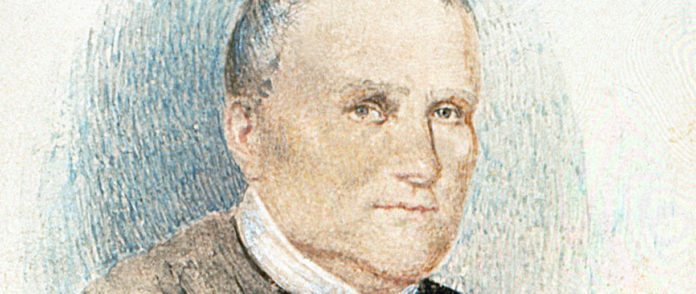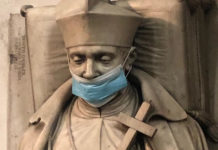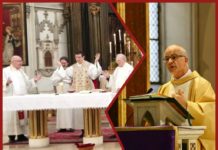The face of St. Clement Maria Hofbauer
Note on the first iconography
At the sound of the bells of the Angelus, on March 15, 1820, St. Clement Maria Hofbauer died. His body was dressed in the Redemptorist habit, a purple stole, embroidered with the symbols of passion, and the biretta. It was moved to the empty house of the Ursuline chaplain to facilitate mourning visits. The sad news quickly spread throughout Vienna and a crowd of devotees flocked to greet the Saint the last time.
Late at night, after the flow of visitors had ceased, the Jesuit Fr. Friedrich Rinn, one of the saint’s fervent followers, began to paint his portrait, putting at the bottom of it the phrase of the Ecclesiasticus: “Beati qui te viderunt, et in amicitia tua decorati sunt” (Sir 48:11).
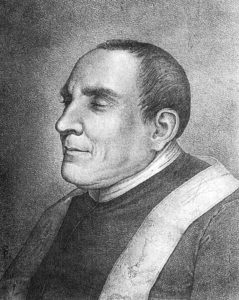
From this painting (Fig. 1), as noted by Fr. Michele Haringer (Vita del beato Clemente M. Hofbauer, Rome 1888, 332 note 4), almost all the iconography of St. Clement Maria Hofbauer was born.
This, however, was not the first image of the Saint painted by Fr. Rinn. In fact, he had already done it while St. Clement was still alive. It is a small watercolor drawing on cardboard, preserved in the Archive of the Redemptorist Province of Vienna (Fig. 2).
While in the portrait of March 15, 1820, the Saint is contemplated in the quiet repose of death, in the watercolor he is depicted posing, probably seated, with his head turned to the observer and his left hand on his straight arm resting on an imaginary table. The absence of the correct anatomy of the bust and the lack of definition of the face and hand, leads one to suppose that this is a sketch, with a view to a subsequent definitive painting. Probably Rinn quickly drew up the Saint, more careful in grasping the morphological specifications of the head and the expression of the face than in taking care of formal correctness.
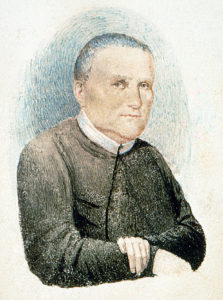
In both representations, however, it is possible to note that the Saint’s expression is serene and smiling. This is a characteristic that several witnesses at the canonization process had to remember. Among the many, Sister Giacoma de Welschenau underlined that: “His appearance was imprinted with a lovable seriousness, a quiet joy, and a peace not disturbed by a real passion” (Haringer M., o.c., 340).
From the following iconography, it can be seen that the artists did not always refer only to the last work of the Rinn. In fact, a few decades after the death of St. Clement, canon E. von Unkrechtsberg, an oblate of the Redemptorist Congregation, commissioned a portrait with watercolor as its reference and sent a photo of it to the artist Joseph von Führich (1800-1876). The latter, called “The Theologian with Pencils”, was the most important exponent of the Nazarene painting movement in Austria and, since 1840, professor of historical composition at the Vienna Academy.
Von Unkrechtsberg, in his letter, specified that, in the watercolor, “with the exception, perhaps, of his hair, which is too short and too grey”, the “Servant of God” was depicted with the unmistakable brilliance he had before his death (Cf. Monumenta Hofbaueriana, XII, 1939, 59).
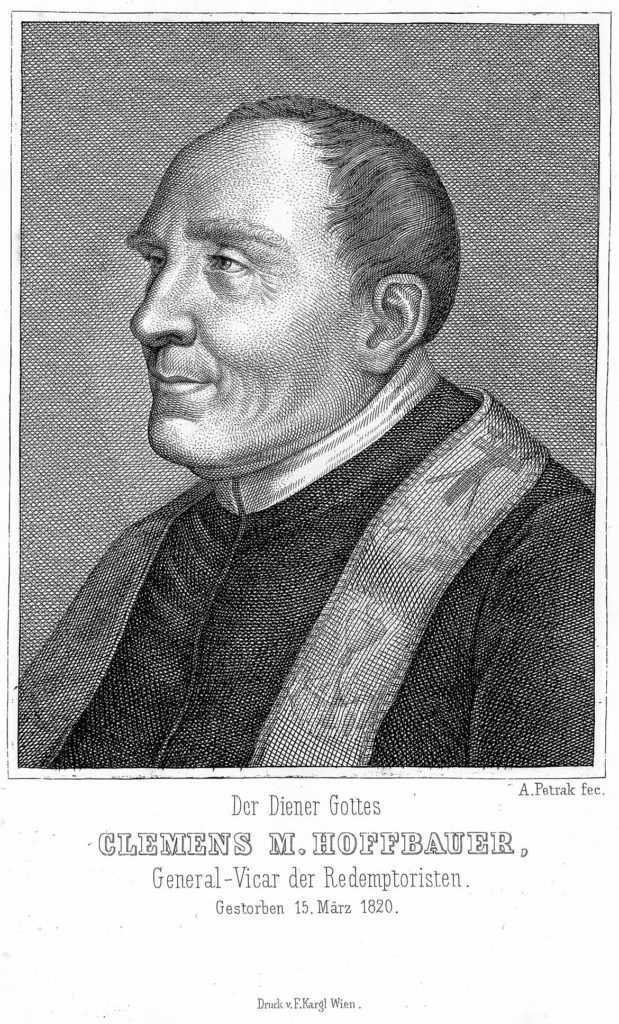 Excluding the engraving by A. Petrak, dated 1864 (Fig. 3), which sequentially reproduces the portrait of 1820, in the works of later artists, among them: H. Windahausen Jr, H. Burkhardt, G. Gagliardi, just to name a few, it is possible to verify that they all took the two Rinn works as models, in some cases individually, in others by merging them into a single composition.
Excluding the engraving by A. Petrak, dated 1864 (Fig. 3), which sequentially reproduces the portrait of 1820, in the works of later artists, among them: H. Windahausen Jr, H. Burkhardt, G. Gagliardi, just to name a few, it is possible to verify that they all took the two Rinn works as models, in some cases individually, in others by merging them into a single composition.
If from the two portraits of Fr. Friedrich Rinn it is possible to know the somatic features and the most characteristic expression of St. Clement, from the detailed description of his first Viennese follower, Giuseppina Biringer, we are also given to know the connotations of physical stature, bearing and clothing. This is how Biringer testified at the process of canonization: “He was of medium stature and robust build, his chest and shoulders were wide, his neck rather short, his head round and well-formed, his face rather round than oblong. Though he always maintained a dignified demeanor, he was lovable and smiling. His eyes were ordinarily ajar; but when he spoke of any truth of the faith, then he would come out of them like a flash of lightning. He walked straight ahead, only his head was somewhat bent forward. Though he ate little and was oppressed by continual toil, he could not be said to be emaciated; and although he was immediately seen to be a strong and energetic man, neither his body posture nor any other movement was haughty. He always wore the habit of his congregation; in the summer he wore a cloak of light black cloth with a collar up, which he used to wrap around himself so that the rosary which he usually held in his hand could not be seen; in the winter he wore a ferraiolo (type of cape) of turquoise cloth. The head, even when he went out into the public streets, had covered it with a simple black papal-shaped calotte (skull cap). His hair was black, and in the last few years, he was rather gray” (Hariger M., o.c., 338).
Frs. A. Marrazzo C.Ss.R. – A. Owczarski C.Ss.R.



